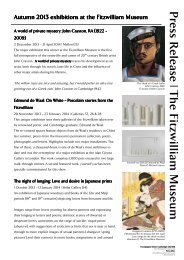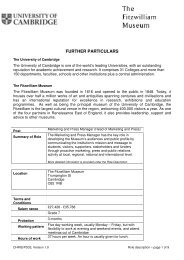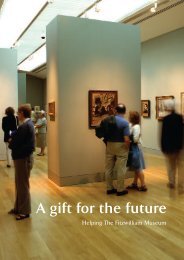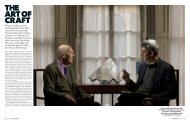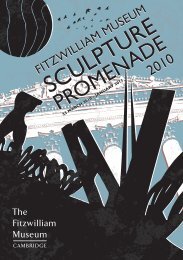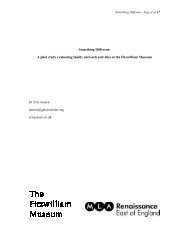The Fitzwilliam Museum - University of Cambridge
The Fitzwilliam Museum - University of Cambridge
The Fitzwilliam Museum - University of Cambridge
You also want an ePaper? Increase the reach of your titles
YUMPU automatically turns print PDFs into web optimized ePapers that Google loves.
Pr<strong>of</strong>ile: Paul Mellon KBE (1907 - 1999)<br />
Paul Mellon, philanthropist and art collector, was born on 11 June 1907 in Pittsburgh, Pennsylvania,<br />
the only son and second <strong>of</strong> the two children <strong>of</strong> Andrew Mellon (1855-1937), banker and statesman,<br />
and his wife Norah (1879-1973), daughter <strong>of</strong> Mr and Mrs Alexander McMullen <strong>of</strong> Hertford, England.<br />
In 1999 Paul Mellon bequeathed $8 million to the <strong>University</strong> <strong>of</strong> <strong>Cambridge</strong> for the <strong>Fitzwilliam</strong><br />
<strong>Museum</strong>. During his lifetime he agreed that £1 million <strong>of</strong> that sum could be allocated to the<br />
Courtyard Development, and under the terms <strong>of</strong> his Will his Executors have subsequently allocated<br />
a further $10 million to complete the renovations associated with the Courtyard, including the<br />
re-lighting <strong>of</strong> all <strong>of</strong> the galleries. <strong>The</strong> remaining balance will be added to the Paul Mellon Fund<br />
which was established as a trust fund for the <strong>Museum</strong> at the time <strong>of</strong> the bequest.<br />
In 1936, during one <strong>of</strong> his regular visits to England, Paul<br />
Mellon bought a painting <strong>of</strong> an eighteenth-century<br />
racehorse, by George Stubbs. Together with his first<br />
wife he saw Pumpkin with a Stable Lad at Knoedler’s<br />
in London. ‘We both were bowled over by the<br />
charming horse, the young boy in a cherry-coloured<br />
jacket, and the beautiful landscape background ... It was<br />
my very first purchase <strong>of</strong> a painting and could be said<br />
to be the impetus toward my later, some might say,<br />
gluttonous, forays into the sporting art field.’ Yet it<br />
remained, for more than a decade, an isolated<br />
purchase. <strong>The</strong> death <strong>of</strong> Andrew Mellon in 1937 placed<br />
a heavy burden <strong>of</strong> responsibility on the shoulders <strong>of</strong> his<br />
only son, not least for his father’s gift to the nation <strong>of</strong><br />
the National Gallery <strong>of</strong> Art in Washington DC on which<br />
construction had begun in the same year. In 1941, only<br />
weeks after he presented the newly finished building<br />
to President Roosevelt, Paul Mellon was in uniform<br />
under selective service. He spent almost two years as<br />
an instructor at the US army’s cavalry training centre at<br />
Fort Riley, Kansas, before being posted to the <strong>of</strong>fice <strong>of</strong><br />
strategic services in London. After D-Day he served in<br />
France and Belgium before returning to the United<br />
States with the rank <strong>of</strong> major in 1945. A year later, Mary<br />
Mellon died as a result <strong>of</strong> chronic asthma and in 1948<br />
Paul Mellon remarried. No wonder he commented on<br />
that decade <strong>of</strong> his life that ‘there had always been<br />
something else to do.’<br />
In 1945, Paul Mellon rejoined the board <strong>of</strong> the<br />
National Gallery <strong>of</strong> Art where he encountered, among<br />
others, Chester Dale, ‘a tough, hard-bitten stockbroker<br />
with a crisp turn <strong>of</strong> phrase and a taste for stiff martinis’,<br />
who had formed one <strong>of</strong> the finest collections <strong>of</strong><br />
nineteenth century French paintings in America. Dale<br />
had no scruples about using the influence his<br />
collection gave him; both the Art Institute <strong>of</strong> Chicago<br />
and the Philadelphia <strong>Museum</strong> <strong>of</strong> Art elected him to<br />
their boards in hopes <strong>of</strong> securing it. Recognising its<br />
significance for the fledgling National Gallery <strong>of</strong> Art,<br />
Paul Mellon was content to defer to the older man<br />
whose judgment he respected and to serve under him<br />
when he was elected President <strong>of</strong> the Trustees in 1955.<br />
For his part, Dale liked to think <strong>of</strong> Paul and ‘Bunny’<br />
Mellon as protégés whose burgeoning interest in<br />
Impressionism he could guide and encourage. For the<br />
Gallery there was a double benefit. When he died in<br />
1962 Dale, true to the last <strong>of</strong> his promises, bequeathed<br />
his collection to Washington and four years later, in<br />
1966, the Gallery’s twenty-fifth anniversary was<br />
marked by an exhibition <strong>of</strong> some 246 Impressionist<br />
and Post-Impressionist paintings acquired by the<br />
Mellons and by Paul’s sister Ailsa, Mrs Mellon Bruce.<br />
<strong>The</strong> majority <strong>of</strong> these works by Boudin, Manet, Monet,<br />
Renoir, van Gogh, Gauguin and Cézanne were<br />
destined to join the permanent collection.<br />
Much as he shared and encouraged his wife’s<br />
enthusiasm for French art, by the 1960s the incurable<br />
collector had embarked upon an even more ambitious<br />
project, aided and abetted by the London-based art<br />
critic Basil Taylor, whom he met in 1959 after agreeing<br />
19<br />
Pr<strong>of</strong>ile: Paul Mellon<br />
LEFT<br />
Paul Mellon in front<br />
<strong>of</strong> James Ward (1769-<br />
1859) Wychnor Hunt



